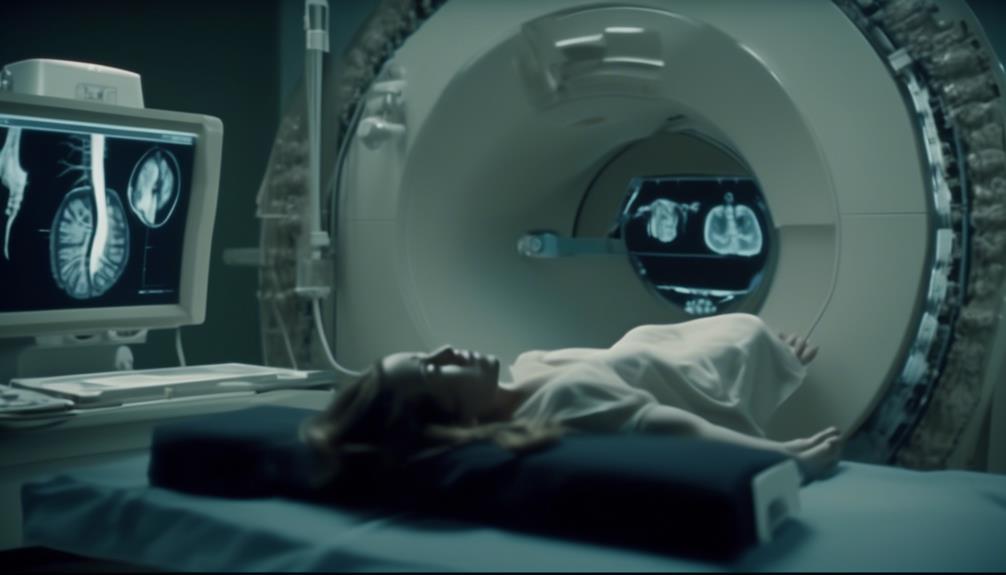CT Scans Revolutionize Imaging (1971) – Hounsfield & Cormack: Recap and Summary: Introduced CT Imaging

Hounsfield and Cormack revolutionized medical imaging with the development of CT scans.
Their invention forever changed the way doctors diagnose and treat patients.
Key Takeaways
- Collaboration and partnerships have played a crucial role in the development and advancement of CT imaging technology.
- CT scans have significantly improved diagnostic accuracy by providing detailed cross-sectional images of the body.
- Advancements in CT scanning technology, such as multi-slice scanners and low-dose imaging techniques, have enhanced image quality and reduced radiation exposure.
- The future of CT imaging holds promise for even faster and more powerful scanners, improved image resolution, and the integration of artificial intelligence to increase diagnostic accuracy and efficiency.
Early Career and Inspiration
During your early career in the field of medical imaging, you gain valuable experience and find inspiration that drives you to revolutionize the field of CT scans. Your early influences, such as mentors and colleagues, play a crucial role in shaping your career trajectory and fostering your passion for innovation.
As a healthcare professional in the field of medical imaging, you're exposed to various imaging techniques and technologies. These experiences expose you to the limitations and challenges of existing imaging methods, fueling your desire to seek better solutions. You witness firsthand the need for more accurate and efficient diagnostic tools, especially in situations where time is of the essence.
Your career trajectory is marked by a relentless pursuit of knowledge and a commitment to pushing the boundaries of medical imaging. You actively engage in research, attending conferences, and collaborating with experts in the field. These interactions provide you with invaluable insights and spark new ideas that have the potential to transform the field.
The inspiration to revolutionize CT scans stems from your unwavering dedication to improving patient care. You recognize the tremendous impact that a more accurate and efficient imaging technique can have on diagnosis and treatment planning. Your passion for advancing the field of medical imaging drives you to explore new technologies and methodologies, ultimately leading you to the groundbreaking development of CT scans.
Collaborative Efforts Begin
As you move into the discussion of collaborative efforts in the field of CT scans, it's important to note that early partnerships were formed to drive joint research initiatives. These partnerships were crucial in advancing the development and application of CT imaging techniques.
Through collaborative efforts, researchers were able to share knowledge, resources, and expertise, leading to significant advancements in the field.
Early Partnerships Formed
Early partnerships were formed to facilitate collaborative efforts in the development and implementation of CT scanning technology. These partnerships played a crucial role in advancing the field of medical imaging and revolutionizing patient care.
One such partnership was between British engineer Godfrey Hounsfield and South African physicist Allan Cormack, who jointly received the Nobel Prize in Physiology or Medicine in 1979 for their pioneering work on computed tomography. Their collaboration allowed for the integration of Hounsfield's engineering expertise with Cormack's mathematical algorithms, resulting in the creation of the first CT scanner.
Additionally, partnerships were formed between medical institutions and technology companies, enabling the translation of CT technology from the laboratory to clinical practice. These early collaborations laid the foundation for the widespread adoption of CT scanning and paved the way for future advancements in medical imaging.
Joint Research Initiatives
Joint research initiatives were initiated to foster collaborative efforts in the advancement and application of CT scanning technology. These initiatives brought together researchers from different institutions and disciplines to share knowledge, expertise, and resources. Collaborative research played a crucial role in pushing the boundaries of CT imaging, allowing for the development of innovative techniques that revolutionized medical diagnostics.
By pooling their resources and expertise, researchers were able to tackle complex challenges and overcome technical limitations. They experimented with new imaging protocols, such as contrast-enhanced imaging and multi-slice CT, to improve image quality and diagnostic capabilities. Collaborative efforts also facilitated the development of specialized software and algorithms for image reconstruction and analysis, enabling more accurate and efficient diagnosis.
These joint research initiatives not only accelerated the development of CT scanning technology but also paved the way for future advancements in medical imaging. By fostering a spirit of cooperation and knowledge exchange, researchers were able to unlock the full potential of CT scanning, revolutionizing the field of medical diagnostics and improving patient outcomes.
Development of the EMI Scanner
The EMI Scanner, a groundbreaking medical imaging device, was developed through the collaboration of engineers and physicians. Its development marked a significant milestone in the field of diagnostic imaging.
The EMI Scanner, short for the Electric and Musical Industries Scanner, was created by Sir Godfrey Hounsfield and Dr. James Ambrose Cormack in the early 1970s. Hounsfield, an electrical engineer, and Cormack, a mathematician, worked together to design and build a machine that could produce detailed cross-sectional images of the human body.
Their work was based on the principle of X-ray computed tomography (CT) scanning. The EMI Scanner utilized a rotating X-ray source and detectors positioned on opposite sides of the patient. These detectors measured the X-ray intensity after it had passed through the body, allowing for the calculation of tissue density.
Overcoming Technical Challenges
Building upon the success of the EMI Scanner, engineers and physicians faced a multitude of technical challenges to further enhance the capabilities of CT imaging. These challenges stemmed from the need to improve image quality, reduce radiation exposure, and increase scanning speed.
One of the key technical advancements was the development of multi-slice CT scanners. These scanners allowed for the acquisition of multiple image slices in a single rotation, significantly reducing scan time and improving patient throughput. Additionally, multi-slice scanners enabled the creation of three-dimensional images, providing a better understanding of complex anatomical structures.
Another technical challenge was reducing radiation exposure. Engineers worked on developing low-dose imaging techniques that would maintain image quality while minimizing the amount of radiation delivered to the patient. This resulted in the implementation of iterative reconstruction algorithms and advanced noise reduction techniques.
Improving image quality was also a major focus. Researchers worked on enhancing spatial resolution, contrast resolution, and reducing image artifacts. This involved advancements in detector technology, such as the introduction of solid-state detectors, which offered better image quality and improved dose efficiency.
Unveiling the First CT Scan
Unveiling the first CT scan brought about a revolutionary breakthrough in medical imaging technology. Here are four key aspects that made this development significant:
- Non-invasive imaging: The first CT scan allowed doctors to visualize internal structures without resorting to invasive procedures. This meant a significant reduction in patient discomfort and the ability to diagnose conditions more accurately.
- Detailed cross-sectional images: Unlike traditional X-rays, the first CT scan produced detailed cross-sectional images of the body. This provided doctors with a three-dimensional perspective, enabling them to identify abnormalities with greater precision.
- Enhanced diagnostic capabilities: The first CT scan introduced a new level of diagnostic capabilities, enabling doctors to detect and diagnose a wide range of conditions, including tumors, bleeding, and fractures. This breakthrough significantly improved patient outcomes by facilitating early detection and intervention.
- Improved patient safety: The first CT scan utilized low-dose radiation, minimizing the potential risks associated with radiation exposure. This made the procedure safer for patients, allowing for repeat scans when necessary.
The unveiling of the first CT scan marked a turning point in medical imaging. It revolutionized the field, providing doctors with a powerful tool to improve diagnostic accuracy, enhance patient care, and ultimately save lives.
Recognition and Impact on Medical Field
CT scans have had a profound recognition and impact on the medical field.
Through ongoing medical advancements and research, CT scans have become an invaluable tool in diagnosing various conditions and diseases.
The improvement in diagnostic accuracy provided by CT scans has revolutionized patient care and treatment outcomes.
Medical Advancements and Research
Medical advancements and research have greatly transformed the field of medicine, revolutionizing patient care and outcomes. Here are four notable examples of how medical breakthroughs and scientific discoveries have made a significant impact:
- Precision Medicine: Advances in genetics and genomics have enabled tailored therapies based on an individual's unique genetic makeup. This personalized approach allows for more effective treatments with fewer side effects.
- Immunotherapy: Breakthroughs in cancer treatment have led to the development of immunotherapies that harness the body's immune system to fight cancer cells. These therapies have shown promising results in treating various types of cancer.
- Artificial Intelligence (AI): AI has revolutionized medical imaging, enabling faster and more accurate diagnoses. Machine learning algorithms can analyze large amounts of data, helping physicians detect diseases at an early stage and improve patient outcomes.
- Regenerative Medicine: Stem cell research and tissue engineering have paved the way for regenerative medicine, which aims to replace or regenerate damaged tissues and organs. This has the potential to revolutionize the treatment of conditions such as heart disease, neurodegenerative disorders, and organ failure.
These medical advancements and scientific discoveries are shaping the future of medicine, offering hope for improved patient care and better health outcomes.
Diagnostic Accuracy Improvement
With advancements in diagnostic imaging technology, the medical field has witnessed a significant improvement in the accuracy of diagnoses. The introduction of CT scans has played a crucial role in this diagnostic accuracy improvement.
CT, or computed tomography, is a medical imaging technique that uses X-ray technology to create detailed cross-sectional images of the body. These images allow physicians to visualize internal structures with exceptional clarity, enabling them to identify and diagnose various medical conditions more accurately. CT scans provide a wealth of information about the body, including the size, shape, and location of abnormalities.
This improved diagnosis capability has had a profound impact on the medical field, leading to better treatment planning, faster recovery times, and ultimately, improved patient outcomes.
Medical imaging, particularly CT scans, continues to evolve, promising even more accurate diagnoses and enhanced patient care in the future.
Advancements and Refinements
Advancements in imaging technology have revolutionized the field of medical diagnostics, providing more precise and detailed information for clinicians. Over the years, there have been significant advancements and refinements in imaging techniques, leading to improved diagnostic capabilities.
Here are four notable advancements that have had a significant impact on medical imaging:
- Multidetector Computed Tomography (MDCT): MDCT has greatly enhanced the speed and resolution of CT scans. With multiple detector rows, MDCT can capture multiple image slices in a single rotation, providing faster and more detailed scans. This advancement has allowed for improved visualization of complex anatomical structures and faster acquisition of images, reducing patient discomfort and radiation exposure.
- Magnetic Resonance Imaging (MRI) with Higher Field Strength: The use of higher field strengths in MRI has led to improved image quality and resolution. With stronger magnetic fields, MRI scanners can produce clearer images, allowing for more accurate diagnosis of various conditions. Additionally, higher field strength MRI has enabled the development of advanced imaging techniques, such as functional MRI (fMRI), which can map brain activity and aid in the diagnosis of neurological disorders.
- Digital Radiography (DR): Digital radiography has replaced traditional film-based X-rays, offering numerous advantages. DR systems provide instant image acquisition, eliminating the need for chemical processing. Furthermore, digital images can be easily manipulated and enhanced, leading to improved visualization of anatomical structures and better detection of abnormalities.
- 3D Imaging: The introduction of three-dimensional (3D) imaging techniques has revolutionized medical diagnostics. With 3D imaging, clinicians can visualize anatomical structures from multiple angles, providing a more comprehensive understanding of complex pathologies. This technology has proven particularly valuable in surgical planning, allowing surgeons to better assess and prepare for complex procedures.
These advancements and refinements in imaging technology have significantly improved diagnostic accuracy and patient outcomes. With ongoing research and development, we can expect further advancements that will continue to revolutionize the field of medical imaging.
Legacy and Future of CT Imaging
As we explore the legacy and future of CT imaging, it's important to acknowledge the significant impact that advancements in imaging technology have had on the field of medical diagnostics. CT imaging has transformed the way we visualize and diagnose diseases, leading to improved patient outcomes.
Looking ahead, future innovations in CT imaging hold great promise for further enhancing diagnostic capabilities. One area of focus is the development of faster and more powerful scanners. These advancements will enable physicians to obtain high-quality images in less time, reducing patient discomfort and allowing for more efficient diagnoses. Additionally, improved image resolution and clarity will provide greater detail, enabling better visualization of small structures and abnormalities.
Another area of future innovation lies in the field of artificial intelligence (AI). Machine learning algorithms have the potential to analyze large volumes of CT images and assist radiologists in detecting and interpreting abnormalities. This integration of AI into CT imaging workflows has the potential to increase diagnostic accuracy and efficiency, ultimately leading to better patient outcomes.
Frequently Asked Questions
How Did Sir Godfrey Hounsfield and Allan Cormack Meet and Begin Their Collaboration?
You both met and started collaborating when you recognized the potential of combining your expertise in mathematics and physics. Overcoming development challenges, your partnership led to the revolutionary development of CT imaging.
What Were Some of the Major Technical Challenges That Hounsfield and Cormack Faced During the Development of the EMI Scanner?
During the development of the EMI scanner, Hounsfield and Cormack faced major technical challenges. These obstacles required precise problem-solving and innovative thinking to overcome. The result was a revolutionary imaging technology that would transform the field of medical diagnostics.
How Long Did It Take Hounsfield and Cormack to Complete the First CT Scan Using the EMI Scanner?
To complete the first CT scan using the EMI scanner, it took Hounsfield and Cormack several years of dedicated work. Their groundbreaking research and technological advancements in CT technology revolutionized the field of medical imaging.
What Were Some of the Immediate ImpaCTs of CT Imaging on the Medical Field?
CT imaging had immediate impacts on the medical field, revolutionizing diagnostic capabilities. Advancements in technology since 1971 have allowed for improved image quality, reduced scan times, and increased patient comfort, making CT scans an indispensable tool in modern medicine.
How Has CT Imaging Technology Evolved and Improved Since Its IntroduCTion in 1971?
Since its introduction in 1971, CT imaging technology has evolved and improved significantly. Through continuous evolution and advancements, CT scans have become more accurate, faster, and safer, revolutionizing the field of medical imaging.








